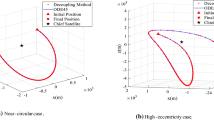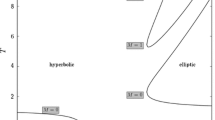Abstract
Lambert’s two-body orbital boundary value problem (BVP) is the determination of the terminal velocity vectors of a trajectory connecting two fixed positions in a specified transfer time. The solution to Lambert’s problem is often the basis for preliminary trajectory design and optimization. In this work, several related two-body orbital BVPs, with constraints involving terminal velocities, flight-path angle, Δv, final radius, transfer angle, etc., are studied. Exact solutions to these BVPs are derived in a universal form via the Kustaanheimo-Stiefel transformation. The solutions are regular and completely analytic if the energy of the transfer orbit is known a priori. Otherwise, they require root-finding of either a polynomial or a transcendental equation with well-defined bounds on its roots. The algorithms developed are validated on several orbit transfer problems and can enable complex mission analysis and parametric studies or serve as initial guesses for high-fidelity numerical optimization schemes.









Similar content being viewed by others
Notes
http://www2.trinity.unimelb.edu.au/~rbroekst/MathX/Quartic%20Formula.pdf [Retrieved on July 26, 2019]
References
Arora, N., Russell, R.P.: A fast and robust multiple revolution Lambert algorithm using a cosine transformation. In: Advances in the Astronautical Sciences, vol 150, pp 411–430. Univelt, Inc., Hilton Head, South Carolina (2014)
Arora, N., Russell, R.P., Strange, N., Ottesen, D.: Partial Derivatives of the Solution to the Lambert Boundary Value Problem. J. Guid. Control Dyn. 38(9), 1563–1572 (2015). https://doi.org/10.2514/1.G001030
Avendaño, M., Mortari, D.: A closed-form solution to the minimum ∖Delta Vˆ2_{tot} Lambert’s problem. Celes. Mech. Dyn. Astron. 106(1), 25–37 (2010). https://doi.org/10.1007/s10569-009-9238-x
Bando, M., Yamakawa, H.: New Lambert Algorithm Using the Hamilton-Jacobi-Bellman Equation. J. Guid. Control. Dyn. 33(3), 1000–1008 (2010). https://doi.org/10.2514/1.46751
Bate, R.R., Mueller, D.D., White, J.E.: Fundamentals of Astrodynamics. Dover Publications, Inc., USA (1971)
Battin, R.H.: An Introduction to the Mathematics and Methods of Astrodynamics, Revised Edition. American Institute of Aeronautics and Astronautics, Reston. https://doi.org/10.2514/4.861543 (1999)
Bombardelli, C, Roa, J, Gonzalo, JL: Approximate analytical solution of the multiple revolution Lambert’s targeting problem. J. Guid. Control Dyn. 41(3), 787–796 (2018). https://doi.org/10.2514/1.G002887
Danby, J.M.A.: Fundamnetals of Celestial Mechanics, 2nd edn. Willmann-Bell, Richmond (1988)
De La Torre, D., Flores, R., Fantino, E.: On the solution of Lambert’s problem by regularization. Acta Astronaut. 153, 26–38 (2018). https://doi.org/10.1016/j.actaastro.2018.10.010
Der, G.J.: The Superior Lambert Algorithm. In: Proceedings of the Advanced Maui Optical and Space Surveillance Technologies Conference, Maui, Hawaii (2011)
Gooding, R.H.: A procedure for the solution of Lambert’s orbital boundary-value problem. Celest. Mech. Dyn. Astron. 48(2), 145–165 (1990). https://doi.org/10.1007/BF00049511. arXiv:1011.1669v3
Izzo, D.: Revisiting Lambert’s problem. Celest. Mech. Dyn. Astron. 121(1), 1–15 (2014). https://doi.org/10.1007/s10569-014-9587-y, 1403.2705
Jezewski DJ: K/S two-point-boundary-value problems. Celest. Mech. 14(1), 105–111 (1976). https://doi.org/10.1007/BF01247136
Jezewski, D.J.: Optimal Two-Impulse Transfer Between Specified Terminal States Of Keplerian Orbits. Opt. Control Appl. Methods 3, 257–267 (1982). https://doi.org/10.1002/oca.4660030304
Kriz, J.: A uniform solution of the Lambert problem. Celest. Mech. 14(4), 509–513 (1976). https://doi.org/10.1007/BF01229061
Lancaster, E.R., Blanchard, R.C.: A Unified Form of Lambert’s Theorem. Technical report, National Aeronautics and Space Administration (1969)
Luo, Q., Meng, Z., Han, C.: Solution algorithm of a quasi-Lambert’s problem with fixed flight-direction angle constraint. Celest. Mech. Dyn. Astron. 109 (4), 409–427 (2011). https://doi.org/10.1007/s10569-011-9335-5
Marscher, W.: A unified method of generating conic sections. Technical report, Massachusetts Institute of Technology Instrumentation Laboratory (1965)
McMahon, J.W., Scheeres, D.J.: Linearized Lambert’s Problem Solution. J. Guid. Control. Dyn. 39(10), 2205–2218 (2016). https://doi.org/10.2514/1.G000394
Prado, A.F.B.d.A., Broucke, R.A.: The minimum delta-V Lambert’s problem. In: Sociedade Brasileira de Automatica, Santos, Brazil, vol. 7, pp. 84–90 (1994)
Prussing, J.E.: A class of optimal two-impulse rendezvous using multiple-revolution Lambert solutions. Adv. Astronaut. Sci. 106(April 2000), 17–37 (2000)
Sangra, D.d.l.T., Fantino, E.: Review of Lambert’s Problem. In: 25Th International Symposium on Space Flight Dynamics, Munich, Germany (2015)
Senent, J.S.: Fast Calculation of Abort Return Trajectories for Manned Missions to the Moon. In: AIAA/AAS Astrodynamics Specialist Conference, Toronto, Ontario, https://doi.org/10.2514/6.2010-8132 (2010)
Senent, J.S., García, J.: Closed-form and numerically-stable solutions to problems related to the optimal two-impulse transfer between specified terminal states of Keplerian orbits. In: Advances in the Astronautical Sciences, vol. 142, pp 2385–2404 (2012)
Shen, H., Tsiotras, P.: Optimal Two-Impulse Rendezvous Using Multiple-Revolution Lambert Solutions. J. Guid. Control Dyn. 26(1), 50–61 (2003). https://doi.org/10.2514/2.5014
Simó, C.: Solución del Problema de Lambert Mediante Regularización. Collect. Math. 24(3), 231–247 (1973)
Stiefel, E.L., Scheifele, G.: Linear and Regular Celestial Mechanics. Springer, New York (1971)
Sun, F.T.: On optimum transfer between two terminal points for minimum initial impulse under an arbitrary initial velocity vector. Technical Report, November, University of Michigan, Ann Arbor (1966)
Sundman, K.F.: Mémoire sur le Problème des trois corps. Acta Math. 36, 105–179 (1912)
Volk, O.: Johann Heinrich Lambert and the determination of orbits for planets and comets. Celest. Mech. 21, 237–250 (1980)
Wilson, SW: Physical Identification of the Extraneous Roots Obtained During Solution of the INRFV Problem. Technical report, Mission Operations Analysis Department, TRW Systems Group (1970)
Zhang, G., Mortari, D., Zhou, D.: Constrained Multiple-Revolution Lambert’s Problem. J. Guid. Control. Dyn. 33(6), 1779–1786 (2010). https://doi.org/10.2514/1.49683
Zhang, G., Zhou, D., Mortari, D.: Optimal two-impulse rendezvous using constrained multiple-revolution Lambert solutions. Celest. Mech. Dyn. Astron. 110 (4), 305–317 (2011). https://doi.org/10.1007/s10569-011-9349-z
Acknowledgements
The authors acknowledge David A. Hoffman of the Flight Mechanics and Trajectory Design branch at NASA-Johnson Space Center for sharing his notes on the classical solutions to some of the boundary value problems discussed in this work.
Author information
Authors and Affiliations
Corresponding author
Ethics declarations
Conflict of Interest Statement
On behalf of all authors, the corresponding author states that there is no conflict of interest.
Additional information
Publisher’s Note
Springer Nature remains neutral with regard to jurisdictional claims in published maps and institutional affiliations.
This work was performed under NASA-Johnson Space Center contract no. 80JSC017D0001 with Gerald L. Condon as the technical project monitor. Partial funding was provided by Texas A&M Engineering Experiment Station under the Space Act Umbrella Agreement No. SAA-EA-16-22219, dated June 2016 (Annex Number 02).
Appendices
Appendix A: Bounds on the Iteration Variable
For the BVPs with fixed transfer times, e.g., the Lambert and reentry BVPs, the transfer-time equation must be solved iteratively using numerical root-finding methods. The iteration variable is the argument (z) of the Stumpff functions. It is essential to know the bounds on the values of z for each type of conic trajectory. For parabolic transfers, the value of z is trivially 0. For the other two cases, a relation between z and the eccentric anomaly or hyperbolic anomaly is sought, which can be used to compute the appropriate bounds on z. [27] (Chapter III) have shown that the parametric trajectory in \(\mathcal {U}^{4}\) space is an ellipse for an elliptic trajectory in Cartesian space. Similarly, it can also be shown that the parametric trajectory in \(\mathcal {U}^{4}\) is a hyperbola for a hyperbolic trajectory in Cartesian space. Therefore, the orbital plane of the two-body trajectories in \(\mathcal {U}^{4}\) parametric space remains fixed. Without loss of generality, it is assumed here that the u1-axis is aligned with the apse line of the conic trajectory in \(\mathcal {U}^{4}\) and the initial point of the trajectory corresponding to s = 0 has only the u1 component. As a result, the initial conditions take the form
Substitution of the preceding equations in Eq. 15 results in
Therefore, the radius of the orbit is given by
Using the definition of the Stumpff functions, the preceding equation for an elliptic trajectory may be written as
and for a hyperbolic trajectory as
It can be shown by comparison with the standard orbit equations that \(E=2\sqrt {z}\) (elliptic) and \(H=2\sqrt {-z}\) (hyperbolic), where E is the eccentric anomaly and H is given by the relation
where f is the true anomaly. Therefore, for an elliptic transfer, z is bounded by (0,π2), whereas for an hyperbolic transfer, z is bounded by \((-\infty ,0)\). The latter result is due to the fact that the R.H.S. of Eq. 158 approaches unity when Rf approaches infinity. It is noted that for multiple-revolution elliptic transfers, the bounds on z may be chosen as z ∈ (m2π2, (m + 1)2π2), where m is the desired number of complete revolutions.
Appendix B: A Few Stumpff Function Identities
Appendix C: Orbit-Injection BVP Equations
The complete derivation of Eq. 99 for the orbit-injection BVP is given here. First, V0 is expressed in terms of U0 and Uf using Eqs. 20 and 6:
Next, the inner product of Rf and V0 is
where (Uf, U0) is computed by using Eq. 15 and is given by
Further, \((\boldsymbol {U}_{0},{\boldsymbol {U}}^{\prime }_{0})\) can be eliminated from the preceding equation by using
where Eq. 15 is used. Substituting the preceding equation in Eq. 166 and then substituting the result in Eq. 165, the following equation involving a single unknown s is obtained:
where Eq. 160 is also used. This equation is valid for elliptic and hyperbolic transfers, but not for parabolic transfers (for which ρ = 0). The preceding equation can be rewritten as
where
Appendix D: Reentry BVP Equations
First, the reentry transcendental equation given in Eq. 123 is derived by relating the energy of the transfer trajectory and the specified quantities. Using Eqs. 15-16, the inner product of Ue and \(\boldsymbol {U}^{\prime }_{e}\) maybe written as
wherein the argument z of the Stumpff functions is omitted for brevity. Similarly, \((\boldsymbol {U}_{0},\boldsymbol {U}^{\prime }_{0})\) can be computed in terms of \((\boldsymbol {U}_{e},\boldsymbol {U}^{\prime }_{e})\) from Eqs. 18-19, as shown below:
Substituting the above result in Eq. 175 and eliminating \((\boldsymbol {U}^{\prime }_{e},\boldsymbol {U}^{\prime }_{e})\) and \((\boldsymbol {U}^{\prime }_{0},\boldsymbol {U}^{\prime }_{0})\) by using the vis-viva equation results in
Using Eq. 29, the preceding equation can be written in terms of the fixed parameters, the energy of the transfer orbit, and s to obtain the final transcendental equation:
In order to solve the reentry problem using the Lambert transfer-time given in Eq. 45, the quantity (U0, Uf) needs to be expressed in terms of z. The inner products \((\boldsymbol {U}^{\prime }_{e},\boldsymbol {U}^{\prime }_{e})\) and \((\boldsymbol {U}_{e},\boldsymbol {U}^{\prime }_{e})\) can be computed using Eq. 21 to obtain
Elimination of \(s^{2} {c_{1}^{2}}(z){V_{e}^{2}}\) from the preceding equation by using Eq. 179 gives
For real roots, the following condition must be satisfied:
It is noted that the preceding condition for the existence of the reentry solution is the same as that given by Eq. 129. There can be at most two real roots of Eq. 181. For a given root, ρ can be computed from Eq. 44 and 160. Then, the correct root for (U0, Ue) is found by back substituting its value in Eq. 179 with the corresponding value of Ve determined from the vis-viva equation. It is noted that compared to Eq. 128, Eq. 181 has no singularity for ρ = 0.
Computation of Re
If a feasible declination of Re is selected, then the corresponding right ascension values for the prograde and retrograde solutions can be computed. For this purpose, the reentry cone is determined first by computing its aperture as well as the declination and right ascension of its axis. The aperture angle, 2ϕ, is obtained from the transfer angle (𝜃) by using
If 𝜃 lies in the first or fourth quadrant, then the reentry cone axis is in the direction of R0, otherwise it is in the opposite direction. Considering Fig. 7, the declination of Re lies within δmin = δa − ϕ and δmax = δa + ϕ, where δa is the declination of the reentry cone axis. If δmin < − 90∘, then δmin is replaced by − δmin − 180∘ and if δmax > 90∘, then δmax is replaced by − δmax + 180∘. For a fixed reentry declination, δe ∈ (δmin, δmax), the feasible right ascension values are computed by constructing a spherical triangle as shown in Fig. 7. The cosine rule gives
where α is the right ascension of Re with respect to the cone axis. The preceding equation is ill-conditioned for small ϕ and a more useful form can be obtained by using the haversine function as shown below:
where \(\text {hav}(x)=\sin \limits ^{2}(x/2)\). There are two right ascension values corresponding to the posigrade and retrograde solutions. These values are αa + α and αa − α, where αa is the right ascension of the reentry cone axis. It is noted that if |δe − δa| = ϕ, i.e., the fixed declination is either the maximum or minimum value possible, then α = 0 and the reentry right ascension is equal to that of the reentry cone axis.
Rights and permissions
About this article
Cite this article
Mahajan, B., Vadali, S.R. Two-Body Orbital Boundary Value Problems in Regularized Coordinates. J Astronaut Sci 67, 387–426 (2020). https://doi.org/10.1007/s40295-019-00204-0
Published:
Issue Date:
DOI: https://doi.org/10.1007/s40295-019-00204-0




